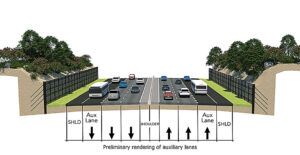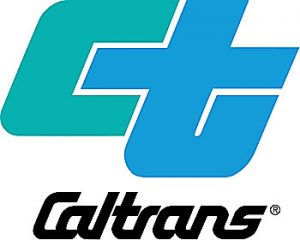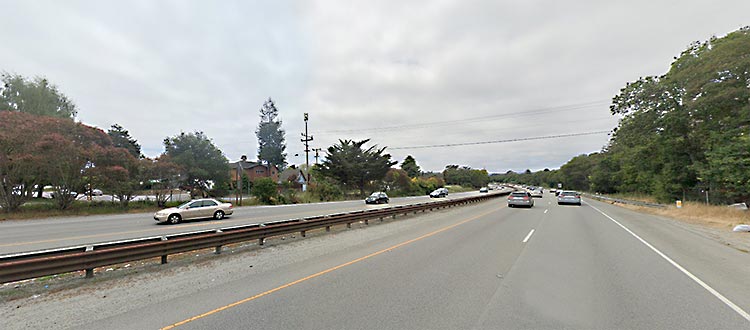By Jondi Gumz
On March 18, the Sierra Club and Campaign for Sustainable Transportation filed a lawsuit in Sacramento Superior Court alleging that Caltrans, in approving plans to widen Highway 1 in Aptos with auxiliary lanes, failed to conduct adequate environmental review.
Caltrans approved the EIR Feb. 20.
![]() Rick Longinotti, chair of the Campaign for Sustainable Transportation, said the auxiliary lanes between State Park Drive and Freedom Boulevard would axe 1,112 trees, including the Moosehead Redwood Grove.
Rick Longinotti, chair of the Campaign for Sustainable Transportation, said the auxiliary lanes between State Park Drive and Freedom Boulevard would axe 1,112 trees, including the Moosehead Redwood Grove.
The lawsuit calls for an injunction to prevent Caltrans and the Santa Cruz County Regional Transportation Commission from proceeding.
The auxiliary lanes, which would make “bus on shoulder” possible and potentially speed bus times and double ridership along with building two overcrossings for people on bicycle and on foot and creating the Coastal Rail Trail are part of the RTC’s $180 million project to reduce Highway 1 congestion.
 “This project is based on the discredited belief that auxiliary lanes will reduce congestion,” Longinotti said. “The Caltrans EIR estimates that congestion in the northbound morning commute would get worse if the project is built. The EIR claims that there would be congestion relief in the southbound afternoon commute in the opening year of the project. However, the EIR estimates the reduction in delay to be short lived. When roadways are expanded, more vehicles fill up the road in what transportation researchers call ‘induced travel.’”
“This project is based on the discredited belief that auxiliary lanes will reduce congestion,” Longinotti said. “The Caltrans EIR estimates that congestion in the northbound morning commute would get worse if the project is built. The EIR claims that there would be congestion relief in the southbound afternoon commute in the opening year of the project. However, the EIR estimates the reduction in delay to be short lived. When roadways are expanded, more vehicles fill up the road in what transportation researchers call ‘induced travel.’”
The lawsuit, filed by William Parkin of Wittwer Parkin, contends that Caltrans’ Environmental Impact Report for the project did not meet the requirements of the California Environmental Quality Act (CEQA). He cited these reasons:
The master EIR for auxiliary lanes from Santa Cruz through Aptos was invalidated in 2012 in a Sacramento Superior Court ruling on a lawsuit filed by the Sierra Club and CFST.
The EIR covering auxiliary lanes did not consider vehicle miles traveled, which the California Environmental Quality Act requires, because Caltrans claimed this kind of project was exempt from that analysis.
This EIR analyzed only the project and the no build alternative, not a range of options as CEQA requires. For example, another option could have been dedicated lanes for buses or building the rail and trail segment parallel to Highway 1.
Longinotti said, “What we need are alternatives to being stuck in traffic. Spending $180 million on a futile project diverts funds from those alternatives.”
He said Minneapolis, Cleveland, and Atlanta have genuine bus-on-shoulder operations that attract riders because the buses are not stuck in traffic.
 Caltrans has said one goal of the project is to improve safety.
Caltrans has said one goal of the project is to improve safety.
Santa Cruz County ranks 5th worst in rate of serious injuries to pedestrians (out of 58 counties) and 2nd worst in rate of injuries to bicyclists.
The Sierra Club contends that investing in transit and making streets safer for bicyclists and pedestrians should be a higher priority than road expansions that don’t reduce congestion.
CFST and Sierra Club scheduled a community meeting at 10:20 a.m. Saturday, March 30, at the Aptos Library to organize community support for alternatives to highway expansion.
•••
Jeanie Ward-Waller, who was deputy director of planning and modal programs at Caltrans, was reassigned in September after she said she told higher-ups that she would file a whistleblower complaint about two road construction projects on Highway 80.
She contends Caltrans described the first project as “pavement rehabilitation” when it was actually freeway widening, using state funds devoted to road maintenance.
She contends the second project should have been considered with the first but by dividing them, Caltrans streamlined permitting and avoided evaluation of alternatives.
She said there is great pressure at Caltrans to deliver projects on time, and more analysis takes more time.

